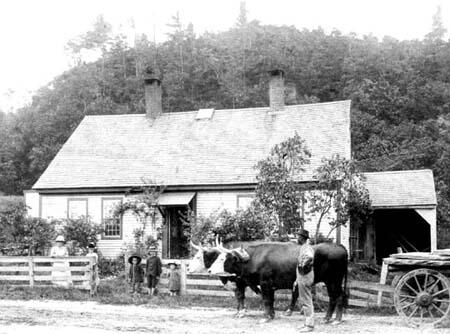by Hans DePold, town historian
(Published in the Bolton Community News, February 2001)
Quarryville was once a bustling boomtown echoing with the hoarse shouts of men splitting veins of granite and flagstone. Rum and religion clashed to influence tough, big-handed men who worked and played hard in the Hollow.
The first mention of a route through the Notch was by French General Chastellux on November 4, 1782. He took it as a shortcut to Coventry to avoid Bolton Center, which was filled with French troops that day. He said it cut three miles of the Post Road route. The first existing record the Bolton Historical Society has of a quarry contract was written by Elijah Phillips with quill pen on parchment in 1809. Phillips was one of the well-known bully boys who employed and worked with quarrymen before the railroad came. (We thank the Sumner family who, while living at the Rose Farm, preserved and recorded much of Bolton's history in the 1800s.)
Bolton granite was of high quality and in demand. The flagstone was a fine micaceous slate use for walkways, door stoops, and school blackboards. Fine Bolton quarry stone was used in Hartford, for the Springfield Armory, and as far away as New York, Albany, Philadelphia, Baltimore, and Washington. Millstones in 1812 weighed between four and five thousand pounds and sold for two cents a pound. The heavy slate and flagstone was taken by ox cart to the Connecticut River for shipment. The picture below was taken in Bolton Notch and shows a quarryman with his ox cart and load posing in front of his trim house. His wife and daughter are wearing their Sunday hats and his three boys are standing in front of their fence.

By 1820 Quarryville had assumed the status of a village and was becoming as important as Bolton Center. Taverns flourished under Col. Chester Daggett, Elijah Fitch, and Jonas Maine (better remembered for his poem about Bolton taxes). Unlike the earlier Bolton Post Road taverns, which were primarily inns where strangers often shared beds or slept on the floor, these new taverns were places to drink and, seemingly, to make pacts with the devil. These were the kinds of taverns that sparked the Temperance movement.
In 1832 Bolton resident Patten Fitch came up with the idea of providing controlled waterpower to the mills in Willimantic by damming up Cedar Swamp, thereby creating Bolton Lake. That worked for many years until the dam's sluice gate fell victim to age and rust and it became impossible to regulate water flow.
Before the railroad came to Bolton, the Notch cut was only about 30 feet deep. In 1836 John W. Barber made a wood engraving of the activity in the stone quarry at the Notch, from which tinted pictures were printed (below). From 1847 to 1849 Turner Stevens led a team of hardy men who blasted the deep east and west railroad cuts through the Notch. Stevens, who was from Danbury, married one of Bolton's Howard girls.

Everyone working for the railroad was flush with $30 pay each month. The old Notch House dance hall stood opposite the train depot and resounded with the fiddling of "Waltz Me Around Again Willie" and other popular tunes of the time. A clubhouse for traveling railroad executives was built just west of Quarryville (see "Memories of Bolton Lodge"). The Quarryville post office opened in 1848 and moved quickly to the railroad depot.
By 1913 the Norwich Turnpike was redirected from Bolton Center to the Notch, where 26 buildings including homes, a soap factory (Martin Chemical Co.), a village store, grain sheds, and coal-weighing scales filled the Hollow with activity. Quarryville had grown along the lake and extended to the area of the Methodist Church built in 1852. The last railroad improvement in Bolton was the widening of the Notch railroad cut in 1929.
The Bolton Lake dam held until the hurricane of 1938. The hurricane took Bolton by surprise. Since the sluice gate could not be opened further to handle the floodwaters, the water flowed over the dam and washed it out. The raging wall of mud, stone, and water took out 500 feet of roads, closing Stony Road, South Road, and South Street in Coventry, depositing the debris in Andover. Luckily, there were no houses in the path. Federal funds were used to rebuild the dam in 1941, but it leaked and immediately washed out a second time and had to be rebuilt. The hurricane of 1956 washed out a critical railroad bridge in Putnam, silencing forever the whistle of trains in Bolton.
Today, with only one of the 26 original Quarryville buildings remaining, Notch Hollow is a ghost of its booming past.